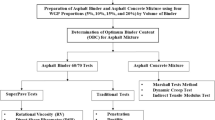Abstract
This study aims to analyze the possibility of valorizing rubber waste in roller-compacted concrete pavement (RCCP) mixes as aggregates. The rubber particles were added to the mix as partial replacement of the total volume of gravels at different rates (5, 10, 15, 20, 25, 30%). The experimental approach followed in this research consisted of studying the effects of the incorporated rubber on the mechanical properties of RCCP. The obtained results show that the incorporation of rubber changes the behavior of RCCP mixes. In presence of rubber, the RCCP became more ductile. The principal disadvantage of rubber incorporation was the decrease in the mechanical properties of RCC. To remedy this problem, the rubber particles were subjected to a treatment and silica fume was added to the mix. The obtained results showed that the performance of RCCP can be improved by modifying the surface roughness of rubber particles. Therefore, a large part of strength losses were corrected.









Similar content being viewed by others
References
ASTM C1176 (2008) Standard practice for making roller-compacted concrete in cylinder molds using a vibrating table. C1176/C1176M-08:1–4. doi:10.1520/C1176
ASTM D1557 (2007) Standard test methods for laboratory compaction characteristics of soil using modified effort (56,000 ft-lbf/ft3(2700 kN-m/m3)). D1557-07:1–13. doi:10.1520/D1557-07.1
Benouadah A, Beddar M, Meddah A (2017) Physical and mechanical behaviour of a roller compacted concrete reinforced with polypropylene fiber. J Fundam Appl 9(2):623–635. doi:10.4314/jfas.v9i2.1
Boudaoud Z, Beddar M (2012) Effects of recycled tires Rubber aggregates on the characteristics of cement concrete. Open J Civ Eng 02(04):193–197. doi:10.4236/ojce.2012.24025
Eldin NN, Senouci A (1993) Rubber-tire particles as concrete aggregtaes. J Mater Civ Eng 5(4):478–496. doi:10.1061/(ASCE)0899-1561(1993)5:4(478)
Gauthier P, Marchand J (2004) Conception et réalisation de revêtements en béton compacté au rouleau au Québec. Association béton Québec (ABQ). Research Report, p.119
HO A (2010) Optimisation de la composition et caractérisation d’un béton incorporant des granulats issus du broyage de pneus usagés: application aux éléments de grande surface. L’Insa de Toulouse, France
Khatib ZK, Bayomy FM (1999) Rubberized Portland cement concrete. J Mater Civ Eng 11(3):206–213. doi:10.1061/(ASCE)0899-1561(1999)11:3(206)
Marchand J, Gagne R, Ouellet E, Lepage S (1997) Mixture proportioning of roller compacted concrete—a review. ACI Spec Publ 171:457–487
Meddah A (2015) Characterization of roller compacted concrete contaning rubber-tire wastes. Thesis, National Polytechnic school of Algiers, p.134
Meddah A, Bali A, Beddar M (2015) Valorization of rubber waste in concrete pavement. In: Beddar M, Meddah A (eds) Journées d’étude de Génie Civil JEGC 2015. M’sila University, Algeria, pp 47–53
Meddah A, Beddar M, and Bali A (2014a) Experimental study of compaction quality for roller compacted concrete pavement containing rubber tire wastes. In: Sustainability, eco-efficiency, and conservation in transportation infrastructure asset management, CRC Press, pp. 273–278
Meddah A, Beddar M, Bali A (2014) Use of shredded rubber tire aggregates for roller compacted concrete pavement. J Clean Prod 72:187–192. doi:10.1016/j.jclepro.2014.02.052
Meddah A, Merzoug K (2017) Feasibility of using rubber waste fibers as reinforcements for sandy soils. Innov Infrastruct Solut 2(1):5. doi:10.1007/s41062-017-0053-z
Naik BTR, and Singh SS (1991) Utilization of discarded tires as transportation facilities. Report No. CBU-1991-02
Nanni A, Meamarian N (1993) Laboratory consolidation methods applied to compacted concrete for pavements. J Mater Civ Eng 5(1):137–143. doi:10.1061/(ASCE)0899-1561(1993)5:1(137)
Raghavan D, Huynh H, Ferraris C (1988) Workabilty, mechanical properties, and chemical stability of a recycled tyre rubber-filled cementitious composite. J Mater Sci 33:1745–1752. doi:10.1023/A:1004372414475
Segre N, Joekes I (2000) Use of tire rubber particles as addition to cement paste. Cem Concr Res 30(9):1421–1425. doi:10.1016/S0008-8846(00)00373-2
Siddique R, Naik TR (2004) Properties of concrete containing scrap-tire rubber—an overview. Waste Manag (New York) 24(6):563–569. doi:10.1016/j.wasman.2004.01.006
Topçu IB (1995) The properties of rubberized concretes. Cem Concr Res 25(2):304–310. doi:10.1016/0008-8846(95)00014-3
Author information
Authors and Affiliations
Corresponding author
Rights and permissions
About this article
Cite this article
Meddah, A., Bensaci, H., Beddar, M. et al. Study of the effects of mechanical and chemical treatment of rubber on the performance of rubberized roller-compacted concrete pavement. Innov. Infrastruct. Solut. 2, 17 (2017). https://doi.org/10.1007/s41062-017-0068-5
Received:
Accepted:
Published:
DOI: https://doi.org/10.1007/s41062-017-0068-5




